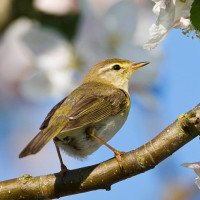Description
Wysokie Hill is easy-to-see, it is the highest point in the area. Barren at the top, covered mostly by meadows from SW and NE, by larch forest culture from SE and mixed shrubbery with trees from NW.
The meadows are nesting places of skřivan polní and strnad obecný. Larch forest edges have great concentrations of singing budníček větší and linduška lesní. Shrubbery from NW is home to hrdlička divoká, pěnice vlašská, pěnice hnědokřídlá, pěnice pokřovní and pěvuška modrá. Sometimes the area gets visited by strakapoud bělohřbetý.
Many birds of prey can be seen regularly hunting in areas below: orel křiklavý, moták pochop, moták lužní, krahujec obecný, káně lesní, poštolka obecná and during winter also moták pilich and káně rousná.
There is a chance to see some other species during migration, i.e.: včelojed lesní, poštolka rudonohá and sokol stěhovavý.
Other common species: kukačka obecná, čáp bílý, strakapoud velký, ťuhýk obecný, ťuhýk šedý, sojka obecná, krkavec velký, sýkora uhelníček, sýkora babka, sýkora lužní , cvrčilka zelená, vlaštovka obecná, mlynařík dlouhoocasý, pěnice černohlavá, králíček obecný, šoupálek dlouhoprstý, drozd kvíčala, bramborníček hnědý, bramborníček černohlavý, dlask tlustozobý, konopka obecná, stehlík obecný.
Details
Access
Accessible from Nowosielce and Pielnia villages - by foot/bike/car/etc. Public transport to these villages limited to buses from Sanok or Krosno. Best to explore by foot, eventually by bike or 4x4 vehicle (not advised and may be problematic). Best to leave larger vehicles somewhere in a village and enjoy the trail by-foot. Field roads are rather dry and don't require rain boots.
Terrain and Habitat
Scattered trees and bushes , Forest , Grassland , Plateau , Valley , Plain , AgricultureConditions
Hilly , Dry , Open landscape , DustyCircular trail
YesIs a telescope useful?
Can be usefulGood birding season
All year roundBest time to visit
Spring migration , Autumn migration , Summer , SpringRoute
Unpaved road , Wide path , Narrow trailDifficulty walking trail
Average walkAccessible by
Foot , BicycleBirdwatching hide / platform
NoExtra info
There aren't really any species here that'd require audio stimulation to show up. Please, avoid doing so. Different birds of prey can be seen during different parts of the day (usually smaller species in the morning and afternoon, larger show up when air is warm enough to soar).
Hazards: ticks, deep snow (winter). Keep in mind presence of other people (hunters, off-road enthusiasts, deltatrike/plane enthusiasts, wanderers), especially during weekends it can get quite busy.




